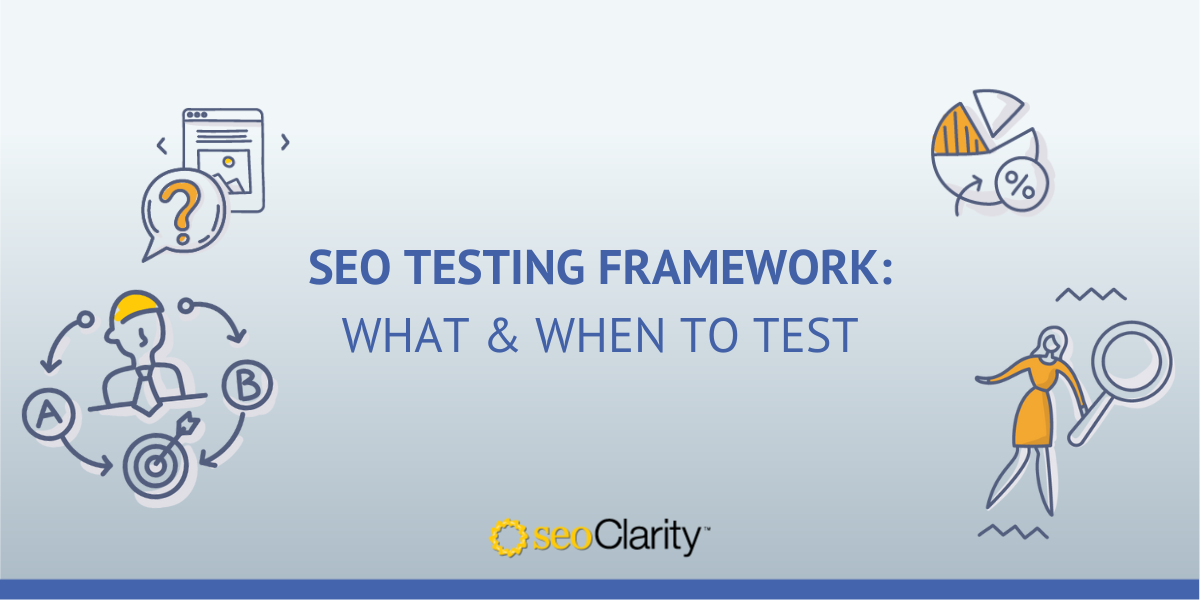
For most SEOs, testing isn’t a novelty idea anymore. They understand the benefits of running SEO tests and many are equally eager to start proving out the value of their work this way.
But there is also an aspect of SEO testing that many practitioners find challenging and that is prioritizing what to test and when.
In this post, I’ll share my ideas for developing an SEO testing framework with you. But first, let’s review the importance of testing.
Why is Testing So Important in SEO?
The idea of testing new hypotheses is long embedded into almost any digital marketing channel.
- Email marketing specialists run split tests to verify what email copy or design factor engages their audience better.
- UX people constantly optimize the site and user experience with multivariate testing or A/B testing.
- It’s almost impossible to increase conversions without running at least some tests either.
SEO is no different. We can also validate ideas, justify projects, and even get buy-in by running various tests.
RECOMMENDED READING: The Right Way to Do SEO Split Testing
I will even argue that we have to do it. It’s so difficult to predict with absolute certainty what elements will help a page or a whole topic cluster to rank well in organic search after all.
Sometimes, we have to look at the performance data, and hypothesize about what else we could do to improve the page’s rankings:
- It might be something as simple as tweaking meta tags to better align them with the search intent.
- We could try to improve keyword placement or expand a page’s content to make it more relevant to the target search phrase.
- Or, our tests might involve researching whether adding Schema will increase the organic CTR, and so on.
The key is that it’s almost impossible to know how these factors improve SEO performance unless you run tests to prove them out.
RECOMMENDED READING: 9 SEO Testing Ideas to Increase KPIs
Unfortunately, as with so many other aspects of our work, there is a catch…
You can’t just start tests at random and expect results to happen. You need a plan. Here are some considerations that will help you develop one.
Challenges With Testing SEO
When you work on a site with hundreds of thousands of pages, you can’t just choose tests ad hoc. Instead, you must take a more strategic approach and develop a testing framework first.
I know from experience that SEOs often face a challenge deciding what to test next, and that’s for several reasons:
- Lack of strategic vision as to what to improve next.
- No insights about what could be tested or what tests would deliver the best results.
- Lack of data and insights to identify issues that could be eradicated by testing different approaches, and so on.
- Feeling inhibited because of a worry that all test ideas have to be good or possible winners
In short, running tests without a plan is nothing but a stressful experience. What makes it even more frustrating is that you know that these tests should be delivering results but you can’t figure out why they don’t.
Not to mention that you have to explain to your manager or executives why your testing program isn’t achieving results.
Having an SEO testing framework means that you can avoid such problems AND run tests that have a meaningful impact on your site’s performance.
Develop an SEO Testing Framework
A testing framework is a set of guidelines and rules that you use to define and design test cases. In most situations, the framework defines how you approach identifying pages or areas of the site that might need to be tested, and how you’d conduct those tests.
Overall, there are three factors that can inform your testing framework.
#1. Traffic and SEO Performance Sweet Spot
The first factor is all about traffic and performance impact. I recommend that you evaluate pages against these three criteria:
- Impressions. For a test to work, the page (or a subset of pages) needs to regularly receive impressions. Otherwise, your test might return no meaningful result. So, look for pages that receive significant enough impressions to ensure that any change you make will deliver noticeable results.
- Low CTR. Another factor to consider is whether the page receives any clicks from the organic search results. If it already shows up in SERPs and receives impressions but the CTR isn’t great, it might be worth investing in tests to see if that can be improved.
- Current rankings. Pages that are almost on page one of the SERP are good testing candidates. Your tests could determine whether visibility can be improved. You could run additional tests then to determine factors that could help improve their positions and CTR.
Look for pages that meet all three criteria:
- Receive a healthy number of impressions
- Their CTR isn’t great, and
- They rank relatively close to page 1 so that your tests can make a significant difference.
seoClarity clients can find their performance sweet spot in Search Analytics (shown above).
#2. Page Type or Category
Identifying pages with good impressions but low CTR will, most likely, still deliver thousands of potential candidates for testing. So, as the next step, consider grouping them by page or content type (i.e., category pages or blog posts).
This won’t reduce the number of potential pages to test but will help you cluster them into categories to filter down for further analysis.
A quick note: You don’t have to run tests on a large number of pages. In fact, I recommend that you do the opposite.
Start with a small group of pages that are roughly the same. Maybe they use the same page template or focus on a similar topic and could be tested together? If they are a mix of templates, then consider subdividing them further and test only one segment (or run parallel tests on each segment).
This way, you’ll be able to test your hypotheses without affecting the performance of all of those pages. And if your theory proves true, you’ll be able to quickly deploy it across other pages and improve their performance too.
#3. Business Impact
The final factor doesn’t relate to SEO performance but the test’s potential impact on the business. In other words, you should first test pages or categories that promise the highest improvement on the business performance.
Here are two ways I recommend you look at it:
The scale of the possible impact. In this approach, you evaluate how many URLs could be positively impacted by the test.
For example, let’s say you’ve identified a segment with 50k pages. However, you already know that only a small percentage of those assets generate traffic and conversions. But because of the segment’s size, you can predict that rolling out the proposed change will impact thousands of other pages and provide a positive ROI. Therefore, the scale of the impact may make testing this segment a priority.
Improvements of high-impact pages. In this case, however, you prioritize segments by their impact on the business results.
For example, you may have identified a segment that includes critical location pages or category pages. Improving their performance, therefore, would obviously have a direct positive impact on the company’s revenue. Therefore, you might choose to prioritize those pages to other segments.
How to Document the SEO Testing Framework
This framework is your way of prioritizing SEO tests. But more often than not, you’ll also have to get buy-in for those initiatives, and this means documenting your framework and presenting it to others.
I’ve found building a simple spreadsheet table with test information to be the most effective way of doing so.
Your table should include such information as:
- Tests you want to run
- Potential scale of each test – how many pages would be affected if the test proves positive,
- Existing data/metrics on those pages to estimate traffic impact on the results.
- Information on which tests would run concurrently.
- Time estimate – how much time will be devoted to this.
Example documentation of tests.
Running SEO Tests at Scale with seoClarity
SEO tests help you use data to confirm which changes that you make to the site or individual pages provide meaningful results. Such tests deliver an invaluable insight that can drive your actions for months and years to come.
To run those tests, you need to:
- You need to figure out what to test, of course, and I hope I helped you solve that problem with the advice I shared above.
- You also have to figure out how to do it at scale. Given the size of a typical enterprise website, you can easily have thousands of potential test candidates. Let me show you some ways to overcome this issue.
For simple tests that focus on improving an individual page’s rankings and performance, a rank tracker could be enough. After all, what you’re changing on the page is aimed at helping to push it higher in rankings.
seoClarity’s Rank Intelligence offers powerful filtering options so you can access all the data to verify whether the test was positive.
The same happens with working on winning a featured snippet for a particular keyword, and so on. Once again, you can use filters to monitor changes to your featured snippets, and evaluate whether your hypothesis was correct.
But in our work such individual tests are rare, aren’t they?
Most of the time, you need to test at least a small group of pages to figure out ways to improve performance of the entire cluster.
And to do that, you need to track more data than just rankings.
Luckily, it’s not all bad news – You can access that information with seoClarity’s SEO Split Tester.
SEO Split Tester lets you run tests on control and testing groups of pages, and analyze the results. What’s more, you don’t have to spend massive amounts of time to verify correlations and do all the math involved to figure out whether the test was successful.
seoClarity SEO Split Tester makes SEO analysis simple and fast. Just choose your test and control pages, the metrics you want to base the test on, and test dates.
SEO Split Tester:
- Evaluates the correlation strength of your proposed test,
- Monitors the selected metric, and
- Provides you with analysis of any change.
On top of that, ClarityAutomate enables you to deploy these tests in minutes, therefore scaling your testing program across as many pages as you need.
Interested in finding out more? Check out how SEO Split Tester lets you run your own SEO tests with no dev work required.




